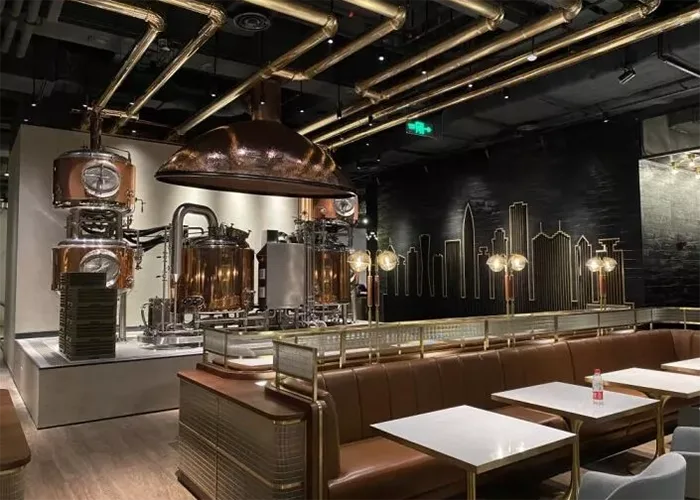Starting a new microbrewery is an exciting thing, but it also requires a lot of work. First, you have to find the right location, then you need to decide which equipment to buy from the microbrewery supply and how much space they need. If you’re not thinking about the actual brewing process – this can be tricky! We’ll help you through all of these steps with a step-by-step guide on how to successfully open your own microbrewery:
- The process of starting your microbrewery
- Brewery capacity and brewery business scope
- Brewery location and brewery layout
- Beer equipment & brewing process custom made
- Beer equipment procurement and installation
The process of starting your microbrewery
Whether you are a craft beer lover or a novice, there are many factors to consider when starting your microbrewery. You need to decide which Brewery System is the best one for your business.
The micro / commercial brewery system uses mash, lauter, and kettle / whirlpool to initiate the process. The three large micro-brewing devices can be used with smaller equipment such as fermenters and energy equipment, as well as other accessories such as centrifuges, pasteurizers and canning production lines. They are designed for larger volumes of beer (7-barrel brewing systems or more) than other systems that require less space but have less flexibility in volume size.
Beer bar equipment is similar to the brewery system, but has shrunk a lot. They are often used by small businesses, such as bars or restaurants that supply only their own beer (less than 7 barrels of a brewery). This type of system includes all four main components (Mash/Lauter tun, kettle, and fermenter) but not pumps or heat exchangers for cooling hot malt during fermentation, which must be purchased separately if required.
Brewery capacity and brewery business scope
Brewery Production: This is the amount of beer your brewery can produce monthly / per year. Usually refers to: 7 barrels per batch brewing system, it is important to remember that each brewery has its own unique capabilities, depending on the equipment, labor resources and other factors.
Usually at the stage of building a brewery, you also need to consider the future expansion in the coming years, which does not mean that you can add more fermenters, but rather notice the brewery scale and level of automation to accommodate several batches per day. This is the microbrewery must do before recommended for you, when the chamber size is finalized, we usually recommend you get the automation level possible, this is a different part, such as fermenter, you can easily add in the future, rather than once completed production, upgrade will be very difficult, even need to rebuild the control system with some mechanical structure. Therefore, remember to equip micro / commercial brewery breweries with highly automated systems.

6HL Brewpub
A brewpub is a restaurant which produces beer for on-premise consumption.
On the other hand, micro / commercial breweries will sell mainly on contract supply, such as supermarkets and hotels, a stable way.
So, considering your sales style is another factor in determining which brewery you will build.
Basically the business scope will determine your brewery size.
So micro-breweries / bars are usually smaller than large breweries; therefore, their micro-breweries equipment requirements are not as extensive or complex as the mechanical needs of large enterprises. However, several equipment are still required for brewing small batches of domestic beer, such as refrigerators for storing raw materials and fermenters for postfermentation of the beer. Small breweries also need barrel machines so they can fill the tap with wine —— that will come in handy when customers want to take their drinks instead of drinking from the cups inside.
Or look for microbrewer supplies directly in the Brewers Association.
But for commercial breweries, things have changed, and they need to consider brewing efficiency and reliability, with mostly highly automated configurations in this case, from malt processing to saccharification chambers to fermentation control to packaging.
Brewery location and brewery layout
Your brewery location / layout will have a significant impact on your business. Some small winemakers choose to open stores in rural areas where land is cheap, while others choose urban locations to get closer to the target audience. If you want to open a small city microbrewery, it is important that you find a suitable space for brewing and for bar-room operations.
The layout of your brewery will also affect how long it takes you to make money from beer sales. A thoughtful plan will make work easier for all those involved: employees do not waste time going from place to place; customers do not get lost while finding their preferred beer; and poor safety precautions reduce the risk of accident or injury.
From the perspective of the production stage, this has a great impact on the operation of the brewery. First, the equipment (the real proportion) is used to make simple layout sketches for detail inspection, so as to make the land use as efficient as possible. It means to put each module in the most reasonable position, and to ensure that all of these can be run separately. As a trusted microbrewery supplier, even at the beginning of the brewery establishment phase, we will consider your possible future expansion and plan for your future expansion.
Beer equipment & brewing process custom made
You can also start thinking about the equipment you need when you decide on the location of the brewery.
In fact, as most winemakers, they focus on the brewing process, but no experience with equipment, mechanisms and engineering, so you need a person to turn your ideas and ideas about the brewing process into real brewing equipment, this is the work by Micet Group project manager, they have rich experience in engineering, but also very understanding of brewing technology.
During the discussion, we understood the customer requirements and then shared more options and suggestions on how to achieve these perfectly until we gave the customer a complete understanding of what kind of brewery equipment should be appropriate. A long time may be a necessary process to let both sides fully understand each other. No two brewery devices are identical and means each is designed for you.
Beer equipment procurement and installation
To install and maintain all of these equipment, you must employ qualified employees familiar with all brewing fields: from electrical engineering and mechanical engineering services to project management and construction services. You also need to know how each section works together, so that they will know what to fix when something happens (trust us when we say “problems can happen”). Even if Micet Group is only used as a manufacturer, we provide end users with detailed installation manuals and electrical drawings, referring to installation and wiring. Especially for highly automated systems, we have programmers who can debug the system online during installation. Let us know that you need help!
Starting a small microbrewery can be a fun and rewarding experience. You will have the opportunity to hand-make products that you can share with friends, family, and strangers. The process of starting your microbrewery takes time, but ultimately it’s worth it!




